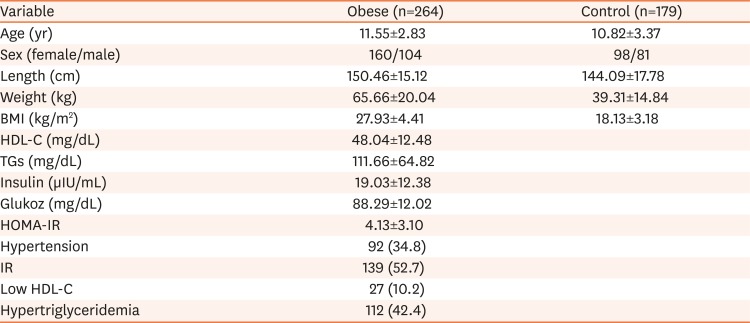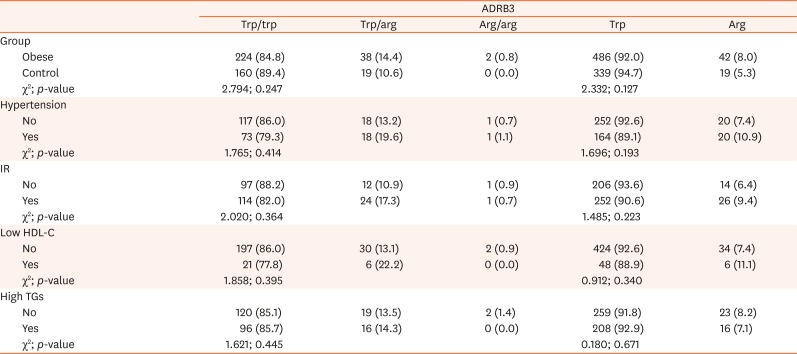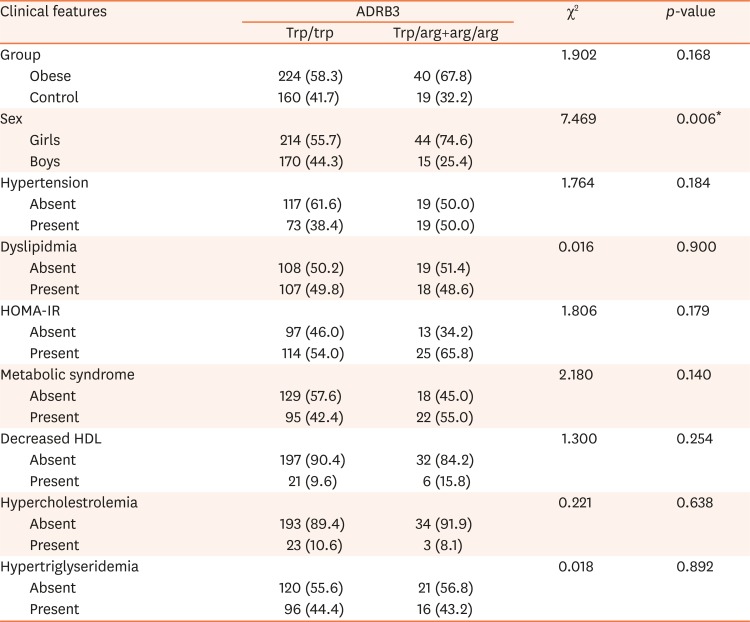1. Simsek E, Akpinar S, Bahcebasi T, Senses DA, Kocabay K. The prevalence of overweight and obese children aged 6-17 years in the West Black Sea region of Turkey. Int J Clin Pract. 2008; 62:1033–1038. PMID:
18021206.
2. Lissner L, Sohlström A, Sundblom E, Sjöberg A. Trends in overweight and obesity in Swedish schoolchildren 1999-2005: has the epidemic reached a plateau? Obes Rev. 2010; 11:553–559. PMID:
20025696.

3. Senol V, Unalan D, Bayat M, Mazicioglu MM, Ozturk A, Kurtoglu S. Change in reference body mass index percentiles and deviation in overweight and obesity over 3 years in Turkish children and adolescents. J Pediatr Endocrinol Metab. 2014; 27:1121–1129. PMID:
25010777.

4. Çıtıl R, Önder Y, Eğri M, Yılmaz R, Özer S, Karaaslan E, et al. Prevalence of obesity and short stature among students in Tokat City. In : 17th National Public Health Congress; 2014 20-24 Ekim 2014; Edirne-TURKEY;2014.
5. Marti A, Moreno-Aliaga MJ, Hebebrand J, Martínez JA. Genes, lifestyles and obesity. Int J Obes Relat Metab Disord. 2004; 28 Suppl 3:S29–S36.

6. Gul A, Ateş Ö, Özer S, Kasap T, Ensari E, Demir O, et al. Role of the polymorphisms of uncoupling protein genes in childhood obesity and their association with obesity-related disturbances. Genet Test Mol Biomarkers. 2017; 21:531–538. PMID:
28704105.

7. Maffeis C. Aetiology of overweight and obesity in children and adolescents. Eur J Pediatr. 2000; 159 Suppl 1:S35–S44. PMID:
11011954.

8. Allison DB, Kaprio J, Korkeila M, Koskenvuo M, Neale MC, Hayakawa K. The heritability of body mass index among an international sample of monozygotic twins reared apart. Int J Obes Relat Metab Disord. 1996; 20:501–506. PMID:
8782724.
9. Valve R, Heikkinen S, Rissanen A, Laakso M, Uusitupa M. Synergistic effect of polymorphisms in uncoupling protein 1 and beta3-adrenergic receptor genes on basal metabolic rate in obese Finns. Diabetologia. 1998; 41:357–361. PMID:
9541178.
10. Silva JE, Rabelo R. Regulation of the uncoupling protein gene expression. Eur J Endocrinol. 1997; 136:251–264. PMID:
9100546.

11. Widén E, Lehto M, Kanninen T, Walston J, Shuldiner AR, Groop LC. Association of a polymorphism in the β 3-adrenergic-receptor gene with features of the insulin resistance syndrome in finns. N Engl J Med. 1995; 333:348–352. PMID:
7609751.
12. Clément K, Vaisse C, Manning BSJ, Basdevant A, Guy-Grand B, Ruiz J, et al. Genetic variation in the β 3-adrenergic receptor and an increased capacity to gain weight in patients with morbid obesity. N Engl J Med. 1995; 333:352–354. PMID:
7609752.
13. Walston J, Silver K, Bogardus C, Knowler WC, Celi FS, Austin S, et al. Time of onset of non-insulin-dependent diabetes mellitus and genetic variation in the beta 3-adrenergic-receptor gene. N Engl J Med. 1995; 333:343–347. PMID:
7609750.
14. Fujisawa T, Ikegami H, Yamato E, Takekawa K, Nakagawa Y, Hamada Y, et al. Association of Trp64Arg mutation of the beta3-adrenergic-receptor with NIDDM and body weight gain. Diabetologia. 1996; 39:349–352. PMID:
8721782.
15. Mirrakhimov AE, Kerimkulova AS, Lunegova OS, Moldokeeva CB, Zalesskaya YV, Abilova SS, et al. An association between TRP64ARG polymorphism of the B3 adrenoreceptor gene and some metabolic disturbances. Cardiovasc Diabetol. 2011; 10:89. PMID:
21992420.

16. Thomas GN, Tomlinson B, Chan JC, Young RP, Critchley JA. The Trp64Arg polymorphism of the beta3-adrenergic receptor gene and obesity in Chinese subjects with components of the metabolic syndrome. Int J Obes Relat Metab Disord. 2000; 24:545–551. PMID:
10849574.
17. Oguri K, Tachi T, Matsuoka T. Visceral fat accumulation and metabolic syndrome in children: the impact of Trp64Arg polymorphism of the beta3-adrenergic receptor gene. Acta Paediatr. 2013; 102:613–619. PMID:
23282015.

18. Arashiro R, Katsuren K, Fukuyama S, Ohta T. Effect of Trp64Arg mutation of the beta3-adrenergic receptor gene and C161T substitution of the peroxisome proliferator activated receptor gamma gene on obesity in Japanese children. Pediatr Int. 2003; 45:135–141. PMID:
12709137.

19. Kim K, Lee S, Lee S, Lim K, Cheun W, Ahn N, et al. Comparison of body fat distribution and blood lipid profiles according to Trp64Arg polymorphism for the β 3-adrenergic receptor gene in Korean middle-aged women. J Nutri Sci Vitaminol. 2006; 52:281–286.
20. Kawaguchi H, Masuo K, Katsuya T, Sugimoto K, Rakugi H, Ogihara T, et al. beta2- and beta3-adrenoceptor polymorphisms relate to subsequent weight gain and blood pressure elevation in obese normotensive individuals. Hypertens Res. 2006; 29:951–959. PMID:
17378367.

21. Gjesing AP, Andersen G, Borch-Johnsen K, Jørgensen T, Hansen T, Pedersen O. Association of the beta3-adrenergic receptor Trp64Arg polymorphism with common metabolic traits: studies of 7605 middle-aged white people. Mol Genet Metab. 2008; 94:90–97. PMID:
18249022.
22. Terra SG, McGorray SP, Wu R, McNamara DM, Cavallari LH, Walker JR, et al. Association between beta-adrenergic receptor polymorphisms and their G-protein-coupled receptors with body mass index and obesity in women: a report from the NHLBI-sponsored WISE study. Int J Obes (Lond). 2005; 29:746–754. PMID:
15917856.
23. Verdi H, Tulgar Kınık S, Yılmaz Yalçın Y, Muratoğlu Şahin N, Yazıcı AC, Ataç FB. β-3AR W64R polymorphism and 30-minute post-challenge plasma glucose levels in obese children. J Clin Res Pediatr Endocrinol. 2015; 7:7–12. PMID:
25800470.

24. Zawodniak-Szałapska M, Stawerska R, Brzeziańska E, Pastuszak-Lewandoska D, Lukamowicz J, Cypryk K, et al. Association of Trp64Arg polymorphism of beta3-adrenergic receptor with insulin resistance in Polish children with obesity. J Pediatr Endocrinol Metab. 2008; 21:147–154. PMID:
18422027.
25. Rawson ES, Nolan A, Silver K, Shuldiner AR, Poehlman ET. No effect of the Trp64Arg beta(3)-adrenoceptor gene variant on weight loss, body composition, or energy expenditure in obese, caucasian postmenopausal women. Metabolism. 2002; 51:801–805. PMID:
12037740.
26. Endo K, Yanagi H, Hirano C, Hamaguchi H, Tsuchiya S, Tomura S. Association of Trp64Arg polymorphism of the beta3-adrenergic receptor gene and no association of Gln223Arg polymorphism of the leptin receptor gene in Japanese schoolchildren with obesity. Int J Obes Relat Metab Disord. 2000; 24:443–449. PMID:
10805501.
27. de Onis M, Onyango AW, Borghi E, Siyam A, Nishida C, Siekmann J. Development of a WHO growth reference for school-aged children and adolescents. Bull World Health Organ. 2007; 85:660–667. PMID:
18026621.

28. Skelton JCR. Overweight and obesity. In : Kliegman R, Nelson WE, editors. Nelson textbook of pediatrics. Philadelphia: Saunders;2007. p. 232–242.
29. Neyzi O, Bundak R, Gökçay G, Günöz H, Furman A, Darendeliler F, et al. Reference values for weight, height, head circumference, and body mass index in turkish children. J Clin Res Pediatr Endocrinol. 2015; 7:280–293. PMID:
26777039.

30. Falkner B, Daniels SR. Summary of the fourth report on the diagnosis, evaluation, and treatment of high blood pressure in children and adolescents. Hypertension. 2004; 44:387–388. PMID:
15353515.

31. Levy JC, Matthews DR, Hermans MP. Correct homeostasis model assessment (HOMA) evaluation uses the computer program. Diabetes Care. 1998; 21:2191–2192. PMID:
9839117.

32. Keskin M, Kurtoglu S, Kendirci M, Atabek ME, Yazici C. Homeostasis model assessment is more reliable than the fasting glucose/insulin ratio and quantitative insulin sensitivity check index for assessing insulin resistance among obese children and adolescents. Pediatrics. 2005; 115:e500–e503. PMID:
15741351.

33. Sangun Ö, Dündar B, Köşker M, Pirgon Ö, Dündar N. Prevalence of metabolic syndrome in obese children and adolescents using three different criteria and evaluation of risk factors. J Clin Res Pediatr Endocrinol. 2011; 3:70–76. PMID:
21750635.
34. Masuo K, Katsuya T, Fu Y, Rakugi H, Ogihara T, Tuck ML. Beta2- and beta3-adrenergic receptor polymorphisms are related to the onset of weight gain and blood pressure elevation over 5 years. Circulation. 2005; 111:3429–3434. PMID:
15956122.
35. Weiss R, Bremer AA, Lustig RH. What is metabolic syndrome, and why are children getting it? Ann N Y Acad Sci. 2013; 1281:123–140. PMID:
23356701.

36. Genelhu VA, Francischetti EA, Duarte SF, Celoria BM, Oliveira RC, Cabello PH, et al. Beta3-adrenergic receptor polymorphism is related to cardiometabolic risk factors in obese Brazilian subjects. Genet Mol Res. 2010; 9:1392–1397. PMID:
20662153.
37. Højlund K, Christiansen C, Bjørnsbo KS, Poulsen P, Bathum L, Henriksen JE, et al. Energy expenditure, body composition and insulin response to glucose in male twins discordant for the Trp64Arg polymorphism of the beta3-adrenergic receptor gene. Diabetes Obes Metab. 2006; 8:322–330. PMID:
16634992.

38. Erhardt E, Czakó M, Csernus K, Molnár D, Kosztolányi G. The frequency of Trp64Arg polymorphism of the beta3-adrenergic receptor gene in healthy and obese Hungarian children and its association with cardiovascular risk factors. Eur J Clin Nutr. 2005; 59:955–959. PMID:
15942638.
39. Urhammer SA, Clausen JO, Hansen T, Pedersen O. Insulin sensitivity and body weight changes in young white carriers of the codon 64 amino acid polymorphism of the beta 3-adrenergic receptor gene. Diabetes. 1996; 45:1115–1120. PMID:
8690160.

40. Li LS, Lönnqvist F, Luthman H, Arner P. Phenotypic characterization of the Trp64Arg polymorphism in the beta 3-adrenergic receptor gene in normal weight and obese subjects. Diabetologia. 1996; 39:857–860. PMID:
8817112.
41. Iwamoto Y, Ohishi M, Yuan M, Tatara Y, Kato N, Takeya Y, et al. β-adrenergic receptor gene polymorphism is a genetic risk factor for cardiovascular disease: a cohort study with hypertensive patients. Hypertens Res. 2011; 34:573–577. PMID:
21289629.

42. Masuo K. Roles of beta2- and beta3-adrenoceptor polymorphisms in hypertension and metabolic syndrome. Int J Hypertens. 2010; 2010:832821. PMID:
20981286.

43. Kadowaki H, Yasuda K, Iwamoto K, Otabe S, Shimokawa K, Silver K, et al. A mutation in the beta 3-adrenergic receptor gene is associated with obesity and hyperinsulinemia in Japanese subjects. Biochem Biophys Res Commun. 1995; 215:555–560. PMID:
7487991.
44. Casey VA, Dwyer JT, Coleman KA, Valadian I. Body mass index from childhood to middle age: a 50-y follow-up. Am J Clin Nutr. 1992; 56:14–18. PMID:
1609751.

45. Fabsitz RR, Carmelli D, Hewitt JK. Evidence for independent genetic influences on obesity in middle age. Int J Obes Relat Metab Disord. 1992; 16:657–666. PMID:
1328090.









 PDF
PDF ePub
ePub Citation
Citation Print
Print




 XML Download
XML Download